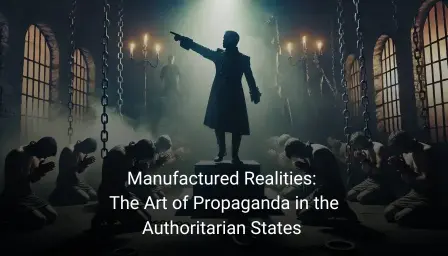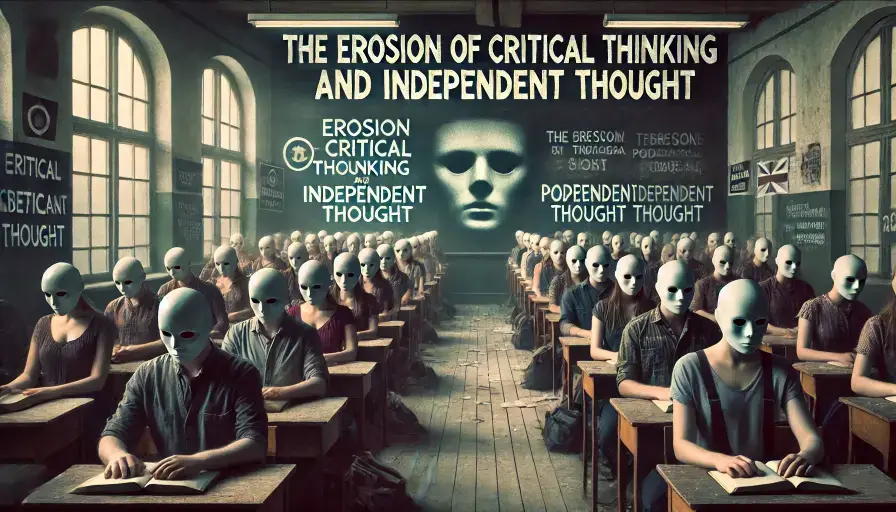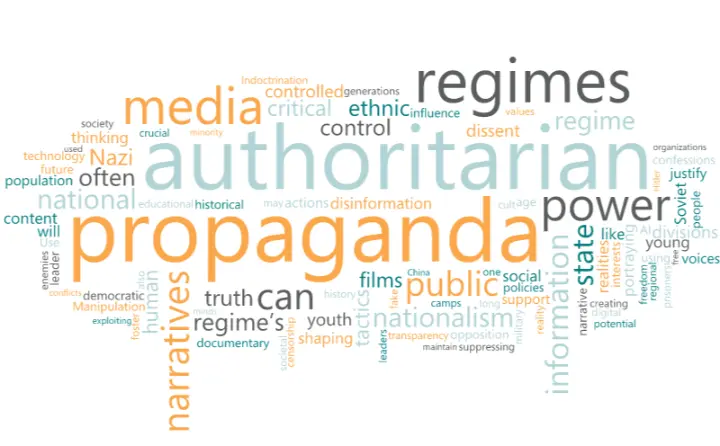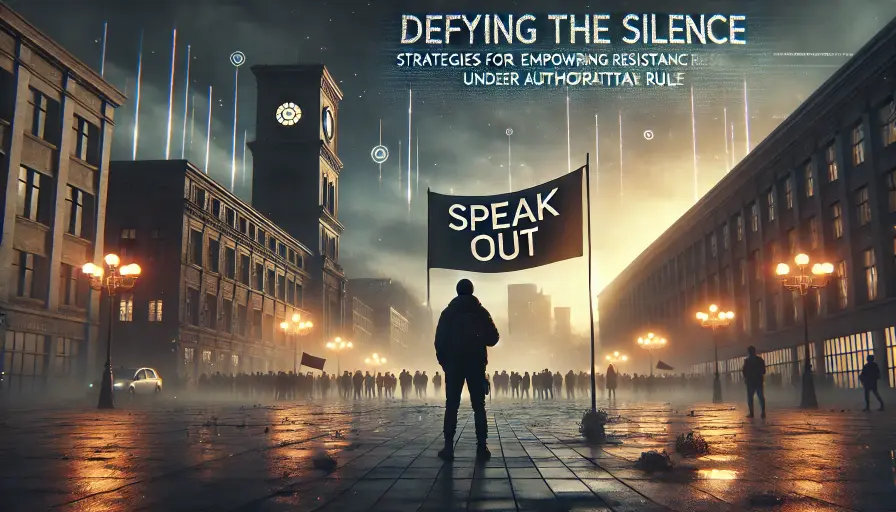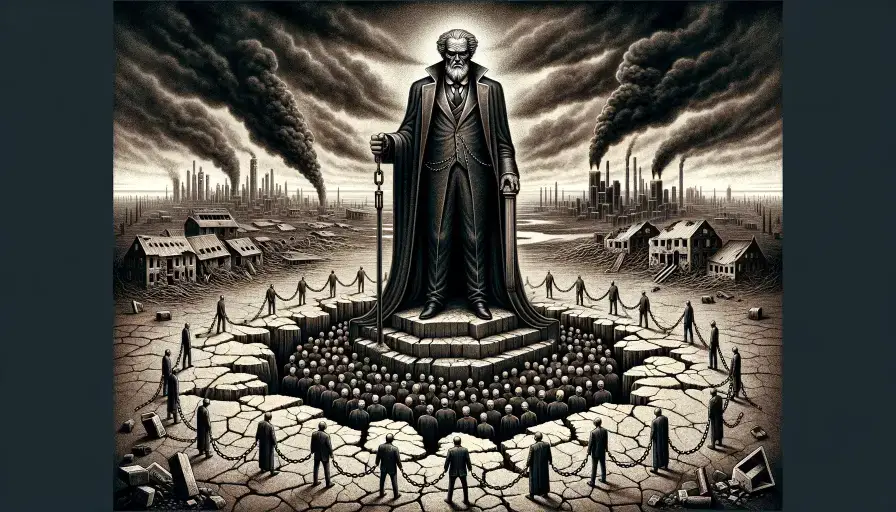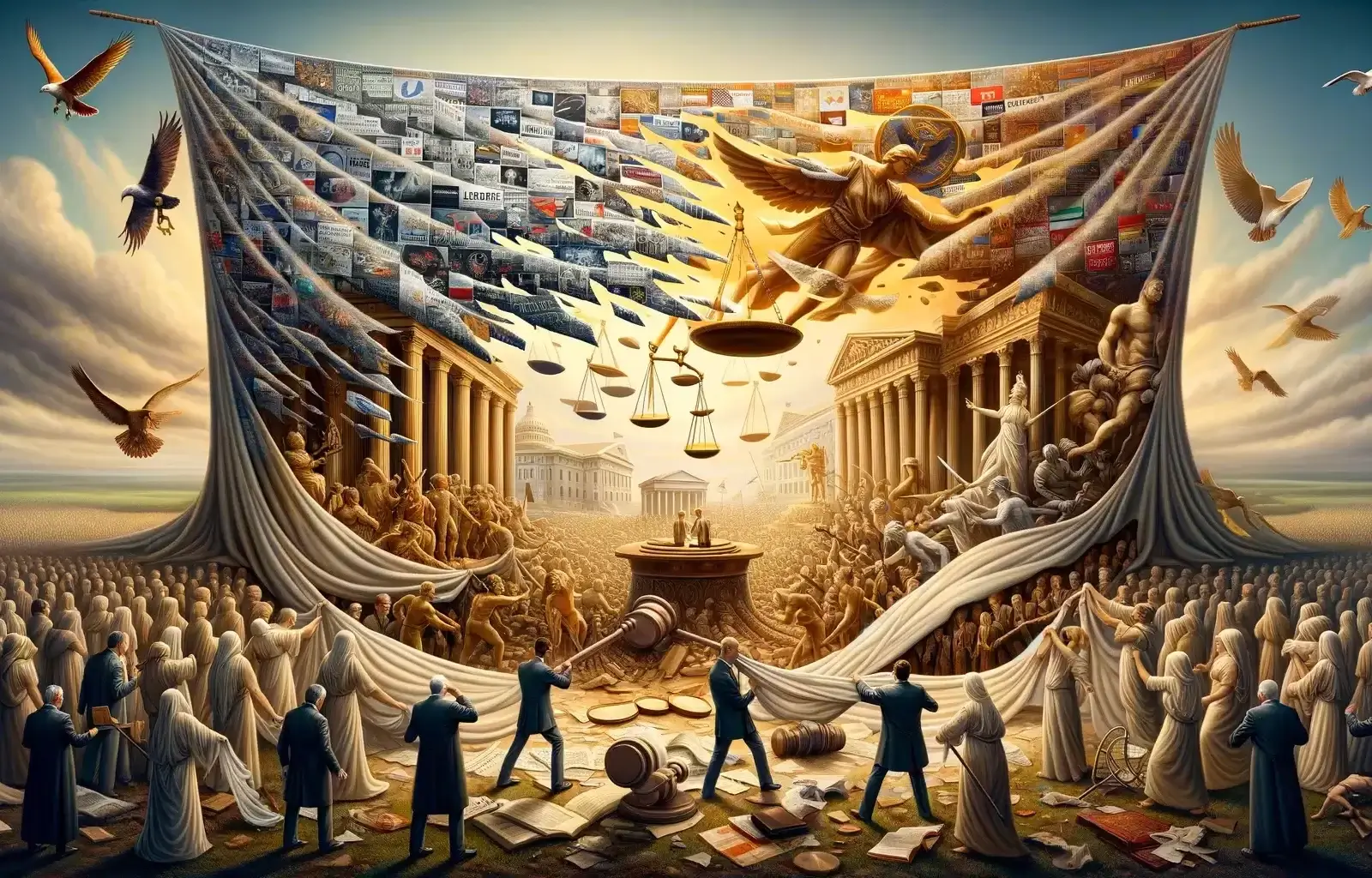Introduction:
Authoritarian regimes, manufactured realities, or propaganda are potent tools for shaping public opinion and maintaining an iron grip on power. These regimes create realities that serve their interests through crafted narratives and orchestrated campaigns, blurring the line between truth and fiction.
From the ashes of Nazi Germany to the oppressive halls of the Soviet Union, history has witnessed the devastating consequences of authoritarian propaganda. In the modern era, this phenomenon persists worldwide, from North Korea’s controlled information ecosystem to China’s sophisticated digital censorship apparatus.
This phenomenon extends to many African authoritarian states, where leaders have employed propaganda to consolidate power and suppress opposition using state-controlled media, and internet censorship continues to shape public narratives.
Such propaganda’s impact extends beyond national borders, influencing global perceptions and international relations. In an age of interconnected media and instant communication, authoritarian regimes have adapted their tactics, leveraging social media platforms and advanced technologies to enhance their message and stifle dissent.
This article explores the complex mechanisms of the authoritarian propaganda apparatus, scrutinizing the strategies implemented, the repercussions experienced, and the pressing necessity for media literacy and analytical reasoning.
We will delve into the psychological tactics employed to manipulate public opinion, the role of state-controlled media in disseminating false narratives, and the challenges citizens face in discerning truth from fabrication.
We will examine the long-term societal impacts of living under constant propaganda and manufactured realities, including the erosion of trust in institutions, suppression of critical thinking, and creation of parallel realities within populations.
Dissecting the Authoritarian Propaganda Machine
Centralized control and censorship
Authoritarian regimes monopolize media outlets and information dissemination, ensuring centralized control over the propagated narratives.
Censorship suppresses dissenting voices and alternative narratives, creating an echo chamber where only the regime’s approved messages resonate.
This stranglehold on information allows for the unhindered proliferation of propaganda, leaving the populace with limited access to unbiased sources.
Cult of Personality and Leader Glorification
A cornerstone of authoritarian propaganda is the cult of personality surrounding the leader. Narratives portray the leader positively, emphasizing achievements and presenting an idealized image that may resonate with supporters.
Culturing cult-like reverence and unwavering loyalty consolidates power and stifles dissent, as challenging the leader becomes akin to challenging the very fabric of the regime.
Scapegoating and Enemy Creation
Authoritarian regimes thrive on creating internal and external enemies, using them as scapegoats to deflect blame and rally the population against perceived threats.
Identifying these ‘enemies’ enables the regime to frame specific measures for national security, consolidating their control. This tactic unites the population against a familiar foe and provides a convenient distraction from the regime’s failures and shortcomings.
Propaganda Techniques and Tactics
1-Repetition and Indoctrination
The relentless repetition of narratives and slogans has been a cornerstone of authoritarian propaganda and manufactured realities throughout history.
Nazi Germany infamously displayed the phrase “Arbeit macht frei” (“Work sets you free”) at the entrances of concentration camps, desensitizing the populace to the horrors within. (Arendt, 1951).
Mao Zedong’s “Little Red Book” was ubiquitous during the Cultural Revolution in China. Its maxims were repeated ad nauseam in schools, factories, and public spaces, indoctrinating an entire generation.
Indoctrination begins at an early age, with educational institutions and youth organizations serving as breeding grounds for the regime’s ideology.
Programs such as the Hitler Youth in Nazi Germany and the Young Pioneers in the Soviet Union aimed to instill loyalty and patriotism from a young age, shaping the minds of the future generation.
2- Disinformation and Manipulation
Authoritarian regimes are masters of disinformation and manipulation, adept at employing tactics like the Big Lie. They repeat gross distortions of the truth so frequently that the populace accepts them as facts.
This relentless repetition of lies and suppression of dissenting voices allows these regimes to shape public perception and maintain control, blurring the lines between reality and fiction.
Josef Goebbels, the Nazi Minister of Propaganda, stated, “If you tell a lie big enough and keep repeating it, people will eventually come to believe it.”
During the Rwandan Genocide, Hutu-controlled media outlets like Radio Télévision Libre des Mille Collines (RTLM) played a pivotal role in spreading disinformation and inciting violence against the Tutsi minority.
They disseminated propaganda portraying Tutsis as “cockroaches” and “enemies,” fueling the flames of hatred and justifying the mass killings.
3-Exploitation of prisoners and Detainees
In their relentless pursuit of control and narrative-shaping, authoritarian regimes turn to those under their custody—prisoners, political dissidents, and detainees—as unwilling participants in their propaganda campaigns.
Reports indicate some regimes use coercive methods to obtain scripted confessions from prisoners, which they present as voluntary.
One chilling example is the use of forced confessions in Soviet-era show trials. The regime coerced prominent figures, including members of the Communist Party, into delivering false confessions of espionage, sabotage, or other crimes against the state.
The regime broadcast and disseminated these confessions, often through brutal means, as “evidence” of its vigilance against perceived enemies, instilling fear and justifying suppressing dissent. (Kenez, 1985)
The Xinjiang region in China is home to a vast network of reeducation camps run by the Communist Party, where Uyghur Muslims and other ethnic minorities face detention, Indoctrination, and forced labor.
Former detainees’ testimonies have revealed instances of coerced confessions and scripted statements praising the camps, which then serve as propaganda to portray the facilities as benign “vocational training centers.”
By exploiting the vulnerable and stripping prisoners of their dignity and autonomy, authoritarian regimes create a distorted reality.
The regime coerces prisoners’ confessions and statements, using them as tools to reinforce its narratives and justify its actions, regardless of how reprehensible they may be.
Countering such tactics requires an unwavering commitment to human rights, transparency, and protecting individuals from exploitation and abuse, even in the face of purported national security concerns.
Upholding these principles can only preserve the integrity of information and challenge the insidious influence of authoritarian propaganda.
4-Spectacles and pageants
Authoritarian regimes have long understood the power of spectacle and pageantry to reinforce their might and instill awe in their subjects.
The Nuremberg Rallies in Nazi Germany featured choreographed displays of power designed to reinforce the regime’s strength and cultivate a sense of national pride, with massive crowds, elaborate staging, and superb architecture.
In North Korea, precision orchestrates mass games and military parades, involving thousands of participants in synchronized displays of loyalty and patriotism.
These spectacles serve as visual propaganda, reinforcing the regime’s authority and perpetuating the cult of personality surrounding the Kim dynasty.
By employing these tactics, authoritarian regimes manufacture realities that serve their interests, distorting truth and shaping public opinion to maintain their grip on power.
Authoritarian regimes often exploit nationalism as a powerful tool in the early stages of their ascent to power. These regimes can rally support, justify their actions, and consolidate their grip on power by tapping into a sense of national pride, identity, and historical grievances.
5-Using Extreme Nationalism
Historical Examples:
Authoritarian regimes often capitalize on extreme nationalism to rally support and consolidate power. They embody the nation’s aspirations and promises to restore pride, strength, and greatness. This resonates and unites people behind a common cause.
Historical examples include Hitler’s Nazis exploiting German resentment after WWI to gain power, Mussolini’s promotion of Italian nationalism to revive Rome’s glory, and Saddam Hussein’s regime evoking Arab nationalism against Western powers.
Invoking nationalism allows regimes to justify aggression under the guise of defending national interests. It also suppresses dissent by labeling critics as “unpatriotic traitors.” While unifying, extreme nationalism is a dangerous tool that can breed xenophobia and discrimination and erode democratic values.
Authoritarian leaders wield this emotional force of nationalism to their advantage, tapping into powerful sentiments of identity, historical grievances, and the promise of redemption to solidify their regimes’ control over the population.
Authoritarian regimes can invoke nationalism to tap into a powerful emotional force that transcends individual interests and unites people behind a common cause.
They often depict themselves as embodying the nation’s aspirations, promising to restore a sense of pride, strength, and greatness that resonates with the population.
Under the guise of defending national interests or reclaiming historical territories, extreme nationalism can justify aggressive foreign policies, territorial expansionism, or military actions. Extreme nationalism can also suppress dissent and opposition by portraying critics as “unpatriotic” or “traitors” to the national cause.
It is critical to acknowledge that nationalism has the potential to foster unity. However, when wielded by authoritarian regimes, it can become a problematic instrument that fuels xenophobia, prejudice against minority groups, and the erosion of democratic principles and human rights.
Sowing Seeds of Indoctrination: Authoritarian Regimes’ Investments in Future Generations
Authoritarian regimes often justify their actions and propagate their ideologies by claiming that the current generation cannot understand, signifying their efforts for the nation.
They assert that future generations, perhaps decades later, will appreciate their decisions’ true impact and wisdom. This narrative instills their thoughts and perspectives into the youth, shaping the minds of those who will carry the regime’s legacy forward.
By portraying themselves as visionaries working towards a more significant, long-term goal, they seek to indoctrinate the young with their manufactured realities and version of reality, ensuring their authoritarian grip on power remains unchallenged for generations.
The strategy involves shaping educational systems and youth organizations, eroding critical thinking, and media content to align with the regime’s narratives. Here are some concrete examples:
1. Educational System Manipulation:
China’s Patriotic Education Campaign: Launched in the 1990s, this ongoing initiative reshapes history curricula to emphasize China’s past humiliations by foreign powers and the Communist Party’s role in national rejuvenation. It aims to foster nationalism and loyalty to the party among students.
Through the school curriculum, North Korean children learn about the greatness of the Kim dynasty from an early age. Subjects like “Revolutionary Activities of Kim Il-sung” are mandatory, instilling unwavering loyalty to the regime.
2. Youth Organizations:
Hitler Youth in Nazi Germany: This organization indoctrinated German youth with Nazi ideology, preparing them for service to the Nazi state.
Young Pioneers in the Soviet Union: This organization for children aged 9-15 promoted communist ideals and loyalty to the Soviet state through various activities and rituals.
3. Media and Entertainment:
Iran’s Islamic Republic of Iran Broadcasting (IRIB): The state-controlled media produces children’s shows that promote Islamic values and anti-Western sentiments.
Venezuela’s “La Villa del Cine” is a state-funded film studio that produces movies and TV shows glorifying the Bolivarian Revolution and its leaders.
4. Technology and Social Media:
China has created the “Little Red App,” a smartphone application, to engage younger, technologically savvy generations in studying Xi Jinping’s philosophy.
5. Rewriting History:
The education system in Turkey under Erdogan has faced allegations of diminishing the significance of Ataturk’s secularist heritage while placing greater emphasis on Ottoman and Islamic history.
6. Summer Camps and Extra-curricular Activities:
Russia’s “Yunarmiya” (Young Army) is a youth organization founded in 2015 that offers military-patriotic education to children as young as eight.
7. Controlling Information Access:
Cuba’s restricted internet access limits young people’s exposure to alternative viewpoints, while state-approved content dominates.
These efforts aim to create generations that unquestioningly support the regime, viewing its ideologies and actions as natural and justified. By shaping young minds, authoritarian regimes attempt to secure their power base for decades to come, making it crucial for them to invest in youth-focused propaganda and indoctrination programs.
This long-term strategy often involves portraying the current regime’s actions as part of a grand vision people may not appreciate in the present but will bear fruit in the future. This narrative aims to rationalize the current hardships or controversial policies by portraying them as crucial sacrifices for a brighter future.
Consequences and Impact:
Decline of Critical Analysis
The decline of critical analysis and the capacity to think autonomously.
The pervasive nature of authoritarian propaganda undermines the ability to think critically and independently. (Ellul, 1965) By stifling dissent and free speech, these regimes discourage questioning and promote blind obedience.
Any deviation from the authoritarian narrative leads to swift and severe consequences, making it the only truth. This erosion of critical faculties leaves the population vulnerable to manipulation and perpetuates the cycle of oppression.
Perpetuating Oppression and Violations of Human Rights
Authoritarian propaganda serves as a justification for repressive measures and human rights violations. By painting dissenters and opposition as threats to national security, the regime legitimizes its crackdown on civil liberties and silences opposing voices.
This enables the consolidation of power and perpetuation of oppressive practices, creating an environment where fear and compliance become the norm.
Societal Divisions and Polarization
One of the most pernicious effects of authoritarian propaganda is its ability to sow discord and polarize societies along various lines, including ethnic, religious, and regional divides.
These regimes can divide and conquer by fomenting tensions and perpetuating an “us vs. them” mentality, weakening the potential for collective resistance and reinforcing their grip on power.
Ethnic Divisions
Authoritarian regimes have stoked ethnic tensions and propagated divisive narratives that pit one ethnic group against another.
In Rwanda, the Hutu-controlled media demonized the Tutsi minority as “cockroaches” and “enemies of the state,” a rhetoric that played a role in the 1994 genocide that killed about 800,000 Tutsis and moderate Hutus.
Slobodan Milošević’s regime in Yugoslavia fueled Serbian nationalism and hatred towards Bosnian Muslims and Croats, paving the way for ethnic cleansing and genocide in the 1990s.
Some African leaders have also exploited ethnic fault lines to maintain power. Common tactics include perpetuating “us vs. them” narratives that portray certain groups as threats.
They are exploiting historical grievances and past conflicts to stoke tensions, manipulating resource conflicts in favor of their ethnic base. They also employ divide-and-rule strategies to prevent unified opposition and scapegoat ethnic minorities to deflect from the regime’s failures.
While contexts vary, the underlying goal is to consolidate power by sowing ethnic divisions, stoking fears, and portraying the authoritarian leader as the sole guarantor of stability.
This dangerous tactic has fueled conflicts, human rights abuses, and societal fragmentation across Africa and internationally. To counter it, we must have inclusive governance and inter-ethnic dialogue and address the root causes of marginalization.
Religious Divisions
Authoritarian regimes have also weaponized religious differences to sow divisions and consolidate power.
The military junta in Myanmar has faced accusations of propagating anti-Rohingya sentiment, depicting the Muslim minority as a threat to the country’s Buddhist identity. This propaganda has exacerbated discrimination, violence, and the forced displacement of hundreds of thousands of Rohingya from their residences.
In India, the rise of Hindu nationalism and the portrayal of Muslims as “anti-national” and “outsiders” by some right-wing groups and politicians have contributed to a polarized society and instances of communal violence.
Regional Divisions
Authoritarian regimes often seek to centralize power and suppress regional autonomy or independence movements.
Propaganda demonized Basque and Catalan separatists during the Franco dictatorship in Spain, portraying them as threats to national unity. They used this narrative to justify suppressing regional languages, cultures, and aspirations for self-determination.
State propaganda in Turkey has long targeted the Kurdish population, portraying them as “terrorists” and “separatists,” fueling tensions and justifying military operations against Kurdish communities.
Division Example
There have been conflicts between ethnic Hutu and Tutsi in Rwanda and between Serbs, Bosnian Muslims, and Croats in Yugoslavia.
The portrayal of Muslims in India as “anti-national” and religious hatred towards the Rohingya people in Myanmar shows the division.
Regional repression is occurring against separatists from the Basque and Catalan regions of Spain and against Kurds in Turkey.
By exploiting these divisions, authoritarian regimes can deflect attention from their failures, justify repressive measures, and perpetuate an environment of fear and mistrust.
Implementing this divide-and-conquer approach erodes societal unity, facilitating the regime’s ability to retain power while stifling opposition and dissent.
Countering these insidious tactics requires a concerted effort to promote inclusivity, tolerance, and a shared sense of humanity that transcends artificial divisions.
By cultivating critical thinking skills and media literacy, communities can actively oppose the appeal of divisive propaganda and strive towards constructing a society characterized by fairness and equality.
Shaping Narratives through Documentary Films
The sheer force of documentary films lies in their capacity to serve as potent instruments of propaganda and manufactured realities. They cloak the narratives they present with an aura of authenticity and credibility.
Authoritarian regimes have recognized this potential and have invested resources into producing and distributing documentary films that advance their agendas.
1- Films such as “The Fall of Berlin” (1949) and “The Unfinished Story” (1955) in the Soviet Union glorified the Red Army’s victory over Nazi Germany.
They portrayed the Soviet Union as a bastion of progress and liberation. The propaganda machinery widely distributed these films to foster national pride and reinforce the regime’s ideological narratives.
2- In contemporary China, the state-backed documentary film industry has helped to shape narratives on sensitive issues such as the Xinjiang region and the treatment of Uyghur Muslims.
Films like “The Wings of Songs” (2021) depict the reeducation camps as benign vocational training centers, contradicting reports of human rights abuses and cultural repression.
The regime distributes these films both domestically and internationally to counter criticism and promote its version of events.
Authoritarian regimes can shape public perception, propagate their ideologies, and silence dissenting voices by controlling the narrative through public-funded media outlets and documentary films.
This monopoly on information allows for the unchallenged dissemination of propaganda, further entrenching the regime’s power and legitimacy in the populace’s minds.
3-The Nazi regime, under Adolf Hitler, used documentary films as powerful tools to propagate their ideologies and shape public opinion. Notable films like “Triumph of the Will” (1935) and “The Eternal Jew” (1940) exemplified this strategy. “Triumph of the Will,” directed by Leni Riefenstahl, showcased the 1934 Nuremberg Rally, using innovative camera work to glorify Nazi power and portray Hitler as a messianic figure.
“The Eternal Jew, directed by Fritz Hippler, was an antisemitic film that dehumanized Jews, justifying the regime’s genocidal policies. These films, shown in cinemas, schools, and public venues, reinforced Nazi ideologies and rallied support for their oppressive policies.
Using such media underscores the power of propaganda and the need for critical thinking, media literacy, a commitment to media freedom, and diverse perspectives to counteract authoritarian influence.
The Role of Emerging Technologies in Modern Propaganda
In the digital age, authoritarian regimes have increasingly used advanced technologies to refine and amplify their propaganda efforts. Artificial intelligence (AI), deep fake Technology, and algorithm-driven content curation have revolutionized the creation and dissemination of disinformation.
AI-powered bots and troll farms can flood social media with state-sponsored narratives, overwhelming opposing voices and creating the illusion of widespread public support. Deep fake Technology, capable of producing realistic but fabricated videos, enables these regimes to craft convincing false narratives, further blurring the line between reality and fiction.
Social media platforms’ algorithms often prioritize sensational or emotionally charged content, inadvertently boosting the reach of propaganda and disinformation. As these technologies develop, so does the sophistication of authoritarian propaganda, posing new challenges for those seeking to counteract its influence.
Modern Propaganda |
Description |
| Social Media Manipulation | – Use of platforms like Facebook, Twitter, YouTube
– Exploitation of algorithms to boost pro-regime content – Deployment of “troll farms” and bot networks |
| Deep fake Technology | – AI-powered creation of convincing fake videos/audio
– Potential for fabricating statements or actions of public figures |
| Big Data and Micro-targeting | – Use of data analytics to identify specific demographic groups
– Tailored propaganda messaging for increased effectiveness |
| Weaponization of Misinformation | – Active spread of “fake news” and conspiracy theories
– Promotion of conflicting narratives to create confusion |
| Cyber Operations | – State-sponsored hacking and leaking of sensitive information
– Cross-border digital influence campaigns |
| AI-Generated Content | – Use of advanced AI models to generate human-like text
– Potential for automating propaganda creation at scale |
| Digital Censorship and Information Control | – Sophisticated firewalls and content filtering systems
– Development of parallel internet ecosystems |
| Influencer Cooption | – Partnering with or pressuring social media influencers
– Leveraging influencers’ audiences and perceived authenticity |
A Call for Vigilance and Strategies to Combat:
Applying Propaganda Insights to Our Realities:
Through the lens of this article, we hope each reader can gain a deeper understanding of how authoritarian tactics manifest in their environment. Recognizing the subtle and overt ways propaganda can shape narratives, from media control to educational influence, readers may become more attuned to similar patterns in their local or national context.
This awareness is crucial whether you live under an authoritarian regime or in a democratic society facing authoritarian pressures. The goal is not to breed paranoia but to foster a more informed, critically thinking citizenry capable of safeguarding democratic values and human rights.
By applying these insights to their own experiences and observations, readers can preserve the integrity of their information ecosystems and political structures, regardless of where they live.
Countering authoritarian propaganda and manufactured realities requires a comprehensive approach that engages individuals, communities, and governments. Enhancing media literacy through education programs and public awareness campaigns empowers people to evaluate information while supporting independent journalism ensures that alternative voices can challenge state-controlled narratives.
Leveraging Technology, such as advanced fact-checking tools and AI, can help detect and mitigate the spread of disinformation. Promoting transparency and open communication within governments builds public trust and reduces the effectiveness of propaganda.
International cooperation is crucial, with global alliances and information sharing playing critical roles in combating disinformation on a broader scale. Fostering social cohesion by promoting inclusivity and encouraging community building helps prevent societal divisions that authoritarian regimes often exploit.
Encouraging critical thinking through educational reforms and public discourse and regulating social media platforms for better content moderation and algorithm transparency can create a robust defense against manipulative tactics. Together, these strategies form a solid response to the threat of authoritarian propaganda and manufactured realities.
Comparing authoritarian propaganda to democratic political communication:
| Aspect | Authoritarian States | Democratic Societies |
| Media Control | Centralized state control | Diverse ownership, including public and private media |
| Dissent | Suppressed or criminalized | Tolerated and protected |
| Information Flow | Tightly controlled | Relatively accessible, with legal protections for press freedom |
| Opposition Views | Silenced or demonized | Allowed and often part of public debate |
| Fact-Checking | Discouraged or punished | Encouraged by independent fact-checking organizations |
| Leader Portrayal | Cult of personality, infallibility | Critical coverage allowed, and leaders held accountable |
| Election Messaging | Often one-sided, with limited competition | Competitive, with multiple parties and viewpoints |
| Use of Fear | A common tactic to control the population | It may be used but typically faces public and media scrutiny |
| Transparency | Limited, with restricted access to government information | Greater, with freedom of information laws |
| Citizen Participation | Controlled and often coerced | Voluntary and encouraged through various channels |
Conclusion
The pervasive influence of authoritarian propaganda and manufactured realities poses a grave threat to the societies under its direct control and the global community. By distorting reality, eroding critical thinking, and justifying repression, these regimes seek to maintain their grip on power at the expense of truth and human dignity.
By monopolizing media outlets, suppressing dissent, and deploying sophisticated psychological tactics, these regimes create alternate realities that serve their interests, often at the expense of truth, freedom, and human dignity. (Welch, 2014).
As we have seen, propaganda is not merely a relic of the past but a living, evolving weapon that continues to shape public opinion and manipulate narratives in the digital age.
Combating manipulative influences that generate manufactured realities has never been more pressing in a world propelled by information. Upholding truth, freedom of expression, and human rights as non-negotiable values is crucial in the fight against authoritarian propaganda—it is a fight for the very essence of democracy. To preserve these principles, we must foster media literacy, support independent journalism, and leverage Technology to combat disinformation.
But no one can fight this battle alone. It requires a collective effort—a coalition of governments, civil society, educators, and everyday citizens—to stand against the tide of misinformation and manipulation. By promoting critical thinking, embracing transparency, and fostering inclusivity, we can build a society resilient to the corrosive effects of authoritarian propaganda.
Now is the time to act. Let us commit to educating ourselves and others, supporting those who speak truth to power, and advocating for policies that protect the free flow of information. Together, we can educate ourselves and others, support those who speak truth to power, and advocate for policies that protect the free flow of information.
We must ensure that the voices of the oppressed are heard, preserve the integrity of our societies, and uphold the values of truth and justice over deceit and tyranny.
Take a stand today—champion truth, defend democracy, and resist the allure of propaganda in all its forms. The future of our world depends on it.
Citations:
Arendt, H. (1951). The Origins of Totalitarianism. Harcourt, Brace, and Co.
Ellul, J. (1965). Propaganda: The Formation of Men’s Attitudes. Vintage Books.
Kenez, P. (1985). The Birth of the Propaganda State: Soviet Methods of Mass Mobilization, 1917–1929 Cambridge University Press.
Welch, D. (2014). The book “Propaganda: Power and Persuasion” was published by British Library Publishing in 2014.

